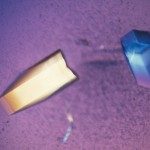Link to Pubmed [PMID] – 17542990
FEBS J. 2007 Jul;274(13):3363-73
Bacterial CMP kinases are specific for CMP and dCMP, whereas the related eukaryotic NMP kinase phosphorylates CMP and UMP with similar efficiency. To explain these differences in structural terms, we investigated the contribution of four key amino acids interacting with the pyrimidine ring of CMP (Ser36, Asp132, Arg110 and Arg188) to the stability, catalysis and substrate specificity of Escherichia coli CMP kinase. In contrast to eukaryotic UMP/CMP kinases, which interact with the nucleobase via one or two water molecules, bacterial CMP kinase has a narrower NMP-binding pocket and a hydrogen-bonding network involving the pyrimidine moiety specific for the cytosine nucleobase. The side chains of Arg110 and Ser36 cannot establish hydrogen bonds with UMP, and their substitution by hydrophobic amino acids simultaneously affects the K(m) of CMP/dCMP and the k(cat) value. Substitution of Ser for Asp132 results in a moderate decrease in stability without significant changes in K(m) value for CMP and dCMP. Replacement of Arg188 with Met does not affect enzyme stability but dramatically decreases the k(cat)/K(m) ratio compared with wild-type enzyme. This effect might be explained by opening of the enzyme/nucleotide complex, so that the sugar no longer interacts with Asp185. The reaction rate for different modified CMP kinases with ATP as a variable substrate indicated that none of changes induced by these amino acid substitutions was ‘propagated’ to the ATP subsite. This ‘modular’ behavior of E. coli CMP kinase is unique in comparison with other NMP kinases.

